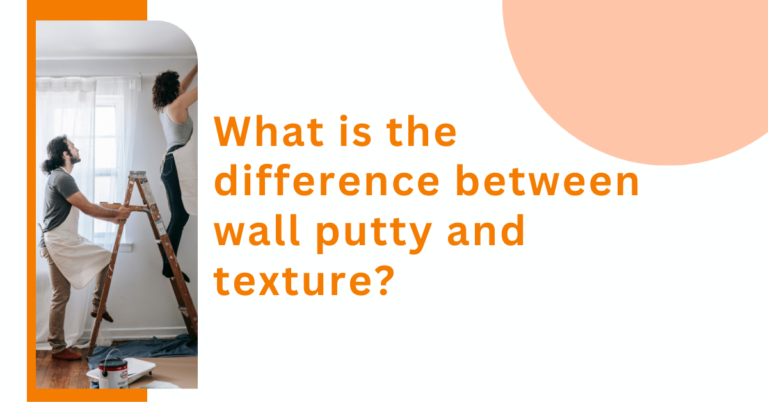Use the best wall putty design for your house, bedroom wall putty design, and modern wall putty texture design to make your walls look beautiful. It is useful for both repairing holes, cracks, and other flaws in walls and for adding beauty to homes.
The word “wall putty” is commonly used while painting your home’s walls, and painters usually take great care to apply different wall putty designs and textures in the most efficient way possible. It makes sense to give it some thought. Before you can comprehend and calculate the paint’s lifespan on your home walls, you need to know why to use modern wall putty texture design and how to use putty in walls to boost the durability of paint.
Paint doesn’t last as long on an unsuitable surface as it does on a building. The type of paint and application technique are not the only factors that affect paint longevity; the substrate and moisture content also play a role. In this case, wall putty application is essential.
Everything you require to understand wall putty design
White powder, which contains premium polymer and minerals, is used to make white cement, sometimes referred to as “wall putty.” Rendering walls, precast walls, aerated lightweight blocks, concrete, etc. can all be decorated with wall putty designs. Walls with small holes, cracks, or other damage can also be treated with it. The freshly applied wall putty texture design gives the walls a flawless polish. It is typically completed prior to the walls’ final painting.
There are two types of wall putty: cement-based and acrylic-based. The acrylic wall putty comes in a paste form that you can apply straight to the walls. They are mostly utilized for walls within buildings.
They are mostly utilized for walls within buildings. Cement-based putty, on the other hand, is powdered and requires mixing with water prior to application. Cement putty is a popular choice at the moment.
Decorating Ideas for Wall Putty.
There are two kind of wall putty available: acrylic and cement-based. The more common kind is wall putty made of acrylic. There is an acrylic wall putty that resembles paste that may be applied straight to the wall’s surface. These are mostly intended for use on interior walls. Conversely, putty made of cement can be purchased as a powder that needs to be combined with water prior to usage. Cement-based putty is the one that is currently most commonly used.
Water-based acrylic putty designed mainly for interior wall application is called acrylic putty. Compared to the plaster of Paris, this putty is a fantastic choice because of its endurance and smooth texture. Acrylic putty is of excellent quality and leaves walls with a lovely, smooth finish. Furthermore, it aids in caulking any wall defects or fissures.
White Cement Putty: One of the most widely used kinds of wall putty in residential structures right now is polymer-based. The putty’s composition of white cement, minerals, and polymers allows it to be applied to both interior and external walls. This putty stands out for having a smooth, brilliant appearance and is well known for providing the walls with an excellent finish. White cement wall putty offers a strong bond and is easy to use.
How is wall putty applied?
Acrylic and wall putty designs provide a flat, smooth surface that is necessary before painting a wall.
- Use a mask and gloves when applying putty to a wall to protect yourself.
2. Before using wall putty, prepare the wall to create a flat surface. Allow it to air dry for a little.
3. It is advised to apply wall putty twice. Allow it to cure for four hours before adding the second coat. For best results, let the second coating dry for the entire night.
4. To smooth the surface once the wall putty has been successfully applied, use sandpaper.
5. Make sure there are no dust or dirt on the surface. Apply paint scraper or sandpaper to the walls to remove oil and limescale.
Using Wall Putty Before Painting Has Advantages
The base concrete or plastered surfaces have a great relationship thanks to the wall putty. When used on internal or external walls, it creates a beautifully painted surface with no undulations. The following are a few advantages of wall putty:
1. The environment is safeguarded.
2. Wall putty can withstand wetness. It provides a more refined outcome.
3. Wall paint has a longer shelf life.
4. Applying two coats prior to painting the walls results in a smoother surface. It offers the ideal concluding touch.
5. It can be used both inside and outside.
6. It prevents the paint from chipping and peeling off or becoming damaged quickly.
7. It requires minimal upkeep.
8. Wall putty increases the tensile strength of the wall.
9. Its resilience keeps patches from damaging the wall.
10. There are numerous applications for it.
11. Using putty is a useful way to reduce the amount of paint applied to the walls.
12. Wall putty provides a smooth, glossy, and appealing surface to the walls, bringing out the real color of the paint.
Advice on How to Apply Wall Putty Perfectly
Preparing the surface:
1. Prior to applying putty, ensure that the surface is made of plastered or cementitious material.
2. Verify that the entire surface is clean. Pollution from dust, loose debris, leftover paint, grease, and oil should be absent.
3. Everything loose and incorrectly adhered should be wiped off the surface by rubbing them down with sandpaper, a wire brush, or a putty blade and then wiping them out.
Blending:
1. Follow the manufacturer’s instructions or add water in a 2:1 ratio to the wall putty mixture in a pan.
2. Use a hand mixer or an electric putty mixer to continuously stir for ten to fifteen minutes. Mix well to obtain a creamy, paste-like consistency.
3. Verify that no lumps form in the mixture.
4. Prepare the mixture so that you can use it in the next two hours.
How to apply wall putty:
One coat of primer should be applied to the wall before putty is applied, and it should be let to dry for at least 12 and preferably 24 hours. While some putty manufacturers recommend using a primer before applying putty, others disagree. Consequently, since the putty’s contents may have an impact on them, pay close attention to the manufacturer’s directions.
1. Apply the initial coat of putty vertically, working from “bottom to top,” using a putty blade, spatula, trowel, or other finishing tools.
2. It is advised by the manufacturer that the first coat be completely dry for at least six to eight hours.
3. To get rid of the small and loose particles left behind after the initial coat dries, just give the surface a quick swipe with sandpaper.
4. The drying time of wall putty may vary depending on the thickness, humidity, and temperature. In certain cases, if you have applied a thick coating or the environment is cool and damp, the drying process will take a lot longer.
How to utilize it most effectively – Final Thoughts
There are numerous wall putty designs available from Colour Valley. Let’s investigate the greatest putty for your home’s walls.
Bison Wall Putty: This powder-based product has a special blend of cellulose, flexible powder polymer, ultra-fine cement, colors, and many other ingredients. It is used for both exterior and interior walls and offers a surface that is smooth and free of undulations.
Bison Flex Putty: It is a premium quality putty composed of white cement with unique properties that may be applied both internally and externally to concrete and mortar substrates to extend the life of topcoat paints and produce a smooth, visually appealing finish.
Happy Wall Acrylic Putty: It is a water-based putty that may be used over an alkali-resistant primer to create a rich, smooth surface. It can be used to fix substrate defects in masonry walls. Its unique texture and buttery feel make application easy.
FAQ
- Are plaster and wall putty the same thing?
Wall putty is used to fill in the pores in walls and ceilings. For smaller works, putty can be applied quickly and simply with a brush or spray. However, it is a white powder that hardens into a substance when mixed with water. This powder can be used to make sculptures and casts, as well as mixed with lime plaster to make casts for broken limbs.
- Is putty required on walls before painting?
The initial step towards attaining durable painting outcomes is the use of putty. It is essential if you are painting something fresh. Painting again using putty It is advisable to apply two coats minimum. When repainting, you won’t need to use putty everywhere if your walls are in good enough condition, but you can use touch-up paint where needed.
- What is the purpose of wall putty?
Fine white cement powder is mixed with water and additional chemicals to create wall putty, which is then applied to the wall as a solution. When the solution is applied correctly, it fills in the gaps and imperfections in the wall, giving your paint a uniform basis.








